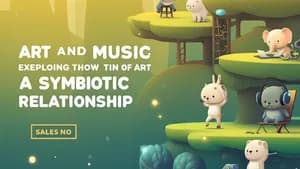The concept of rhythm is fundamental to both art and music. This article examines how artists have incorporated rhythmic patterns into their compositions, creating visual representations of musical beats and tempos, demonstrating a shared language of movement and pulse.
Understanding Rhythm in Art and Music
Rhythm, in its simplest form, is the arrangement of elements in time. In music, rhythm is created by the pattern of sounds and silences, creating a beat or tempo. In art, rhythm is expressed through the arrangement of visual elements like lines, shapes, colors, and textures. Think of the repetitive pattern of a picket fence or the undulating waves of a seascape. This rhythmic repetition creates a visual beat, mirroring the feeling of a musical rhythm.
Imagine a piece of music with a fast, energetic tempo. You would likely visualize a series of sharp, angular lines or a vibrant, chaotic composition, reflecting the dynamic movement and energy of the music. On the other hand, a slow, soothing melody might be represented by flowing curves, smooth gradients, or serene colors, visually echoing the calm and tranquility of the sound.
Visualizing Musical Rhythms
Artists have long utilized visual forms to express musical rhythms. Perhaps the most straightforward example is the use of staff notation, where the arrangement of notes on the staff directly translates the musical rhythm into a visual representation. In the 19th century, composers like Franz Liszt and Hector Berlioz incorporated programmatic music, which sought to depict specific narratives or scenes using musical language. This created a strong link between music and visual imagery, inviting the listener to visualize the emotions and actions conveyed by the music.
Consider these examples:
- Gustav Klimt's painting 'The Kiss' reflects a slow, romantic tempo with its gentle curves and soft colors.
- Wassily Kandinsky's abstract paintings, often titled with musical terms like 'Improvisation' or 'Composition', express a vibrant, dynamic energy through bold lines and contrasting colors.
Exploring the Connection between Visual Art and Music
The relationship between music and visual art goes beyond simple visual representations of rhythm. Both disciplines share a common language of form, balance, and proportion, creating a sense of harmony and order. The way a composer structures a symphony, with its movements and themes, mirrors the way a painter might organize the elements of a composition. Both use repetition, contrast, and variation to create interest and evoke emotions in the viewer or listener.
Practical Activities for Students
You can explore the relationship between music and art through hands-on activities. Here are some ideas:
- Listen to a piece of music and create a visual representation of the rhythm. This could involve drawing lines, shapes, or patterns that reflect the beat, tempo, and mood of the music.
- Choose a piece of visual art and identify the rhythmic elements within it. Analyze the arrangement of lines, shapes, colors, and textures. How do these elements create a sense of movement or rhythm? What kind of music might complement this artwork?
- Compose a piece of music using a visual artwork as inspiration. This could involve using the colors, shapes, and textures of the artwork to inform the melodies, harmonies, and rhythms of your composition.
Conclusion
The relationship between music and visual art is a fascinating and ongoing dialogue. By exploring the visual expression of musical rhythm, you gain a deeper appreciation for the universal language of art and music. As you continue to learn about music and art, remember that the beauty of both lies in their ability to evoke emotions, tell stories, and connect us to the world around us.

